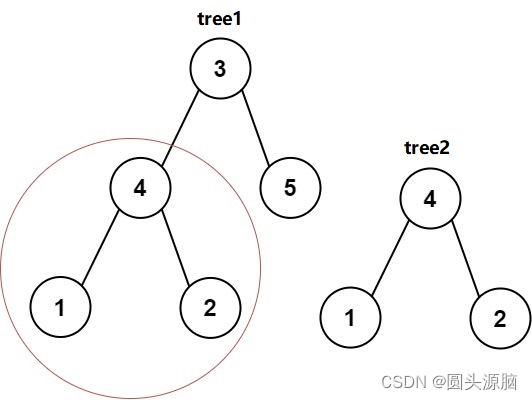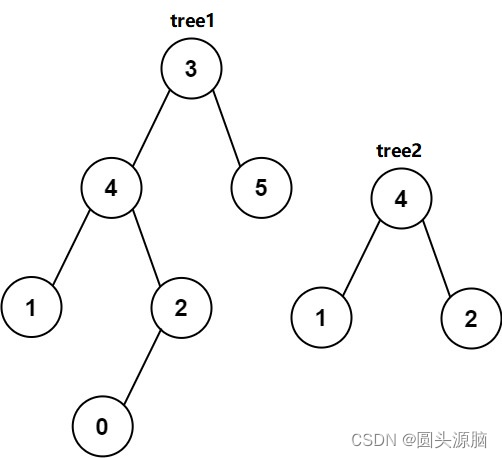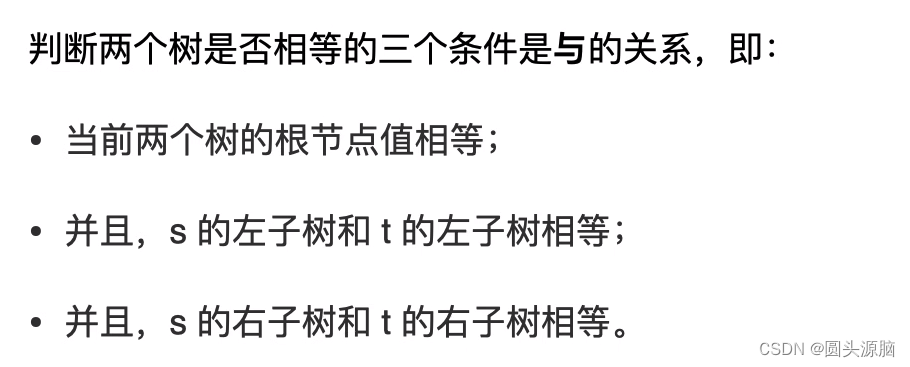Description
给你两棵二叉树tree1和tree2,检验tree1中是否包含和tree2具有相同结构和结点值的子树。如果存在,输出true;否则,输出false。


Input
第一行输入t,表示有t个测试样例。
第二行首先输入n1,接着输入n1个整数,表示二叉树tree1。
第三行首先输入n2,接着输入n2个整数,表示二叉树tree2。
以此类推,每两行输入一个测试样例,共输入t个测试样例。
数组形式的二叉树表示方法与题目:DS二叉树_伪层序遍历构建二叉树 相同,输入-1表示空结点。
Output
每一行输出当前测试样例是否符合题意。
共输出t行。

思路分析:
方法一:深度优先搜索暴力匹配



算法实现:
bool SameTree(BitNode* s, BitNode* t) {
//如果根节点都为空,匹配成功,返回true
if (s == nullptr && t == nullptr) return true;、
//两者之中有一个为空,匹配不成功,返回false
if (s == nullptr || t == nullptr) return false;
//三者都相等才是相等的树,必须满足1.根节点值相等; 2.左子树相等 3.右子树相等
return s->data == t->data && SameTree(s->lc, t->lc) && SameTree(s->rc, t->rc);
}
bool isSubtree(BitNode* s, BitNode* t) {
if (!s) return false;
//如果 目标树是子树的左子树,或者是右子树,或者两者相等,那么目标树则为主树的子树
return isSubtree(s->lc, t) || SameTree(s, t) || isSubtree(s->rc, t);
}
实现代码:
#include<iostream>
#include<queue>
using namespace std;
class BitNode {
//friend bool isSubtree();
//friend bool SameTree();
public:
int data;
BitNode* lc;
BitNode* rc;
BitNode() :lc(NULL), rc(NULL) {};
BitNode(char e) :data(e), lc(NULL), rc(NULL) {};
~BitNode() {
delete lc;
delete rc;
}
friend class BinaryTree;
};
class BinaryTree {
private:
BitNode* root;//头节点
void CreateTree(BitNode*& t, int n, int arr[]);
int* arr = new int[1000];
public:
BinaryTree() :root(NULL) {}
~BinaryTree() { delete root; };
void CreatTree(int n, int arr[]);
BitNode* getRoot() {
return root;
}
};
void BinaryTree::CreateTree(BitNode*& t, int n, int arr[]) {//伪层序遍历构建二叉树
t = new BitNode;
queue <BitNode*> T;
if (arr[0] != -1) {
t->data = arr[0];
T.push(t);
}
else {
return;
}
int count = 1;
while (count < n && !T.empty()) {
BitNode* node = T.front();
T.pop();
if (arr[count] != -1) {
node->lc = new BitNode(arr[count]);
T.push(node->lc);
}
count++;
if (count < n && arr[count] != -1) {
node->rc = new BitNode(arr[count]);
T.push(node->rc);
}
count++;
}
}
void BinaryTree::CreatTree(int n, int arr[]) {
CreateTree(root, n, arr);
}
bool SameTree(BitNode* s, BitNode* t) {
//如果根节点都为空,匹配成功,返回true
if (s == nullptr && t == nullptr) return true;
//两者之中有一个为空,匹配不成功,返回false
if (s == nullptr || t == nullptr) return false;
//三者都相等才是相等的树,必须满足1.根节点值相等; 2.左子树相等 3.右子树相等
return s->data == t->data && SameTree(s->lc, t->lc) && SameTree(s->rc, t->rc);
}
bool isSubtree(BitNode* s, BitNode* t) {
if (!s) return false;
//如果 目标树是子树的左子树,或者是右子树,或者两者相等,那么目标树则为主树的子树
return isSubtree(s->lc, t) || SameTree(s, t) || isSubtree(s->rc, t);
//请不要直接复制粘贴
}
int main()
{
int t;
cin >> t;
while (t--)
{
int n1;
int n2;
cin >> n1;
int* arr1 = new int[n1 + 1];
for (int i = 0; i < n1; i++) {
cin >> arr1[i];
}
cin >> n2;
int* arr2 = new int[n2 + 1];
for (int i = 0; i < n2; i++) {
cin >> arr2[i];
}
BinaryTree* tree1 = new BinaryTree;
tree1->CreatTree(n1, arr1);
BinaryTree* tree2 = new BinaryTree;
tree2->CreatTree(n2, arr2);
if (isSubtree(tree1->getRoot(), tree2->getRoot())) {
cout << "true" << endl;
}
else {
cout << "false" << endl;
}
;
}
}

























 97
97











 被折叠的 条评论
为什么被折叠?
被折叠的 条评论
为什么被折叠?








